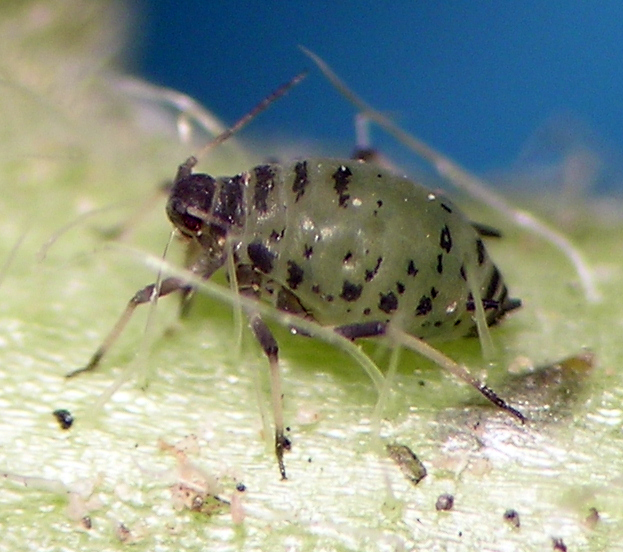Protaphis Börner
This page updated: December 2024.
For many years this group of species was considered part of Aphis. Then somewhere along the way we started using the subgenus name Protaphis for similar Aphis that often live on lower stems and roots of various plants. Recently, we have started using the name Protaphis as a separate genus, apparently due to some DNA sequence evidence that the group is distinct from Aphis evolutionarily. Now, Blackman & Eastop note that there are about 50 nominal species in the group, and many are not clearly distinct from the others. In North America, I have generally applied the name Protaphis middletonii (Thomas) to almost all of my samples based on work by Eastop and Blackman (2005). It seems likely that more than one species are involved in all my samples across western North America, but substantial field and lab work will be required to sort it all out. A major taxonomic problem I see is that dorsal pigmentation appears to be extremely variable in this group. In single samples I see specimens with almost completely dark dorsa to specimens with only isolated small dark makings.
In January 2024 I spent several hours looking through all my Protaphis samples (about 100 slides) to attempt to sort them into groups that might be species. I found a few categories were fairly easy to separate based on length of setae on legs and antennae. The great majority of my samples have short setae on legs and antennae. These can be loosely divided into two categories: 1) those with tibiae and basal parts of antennal segment III pale, and 2) those with antennal segment III dark except at extreme base and tibiae dusky to brown with front tibiae darker than others. I don’t see any clear separation of these two categories based on host plant, geography, habitat type, or time of year. That is, both categories are widespread geographically and are from a range of host plants. They are from both above-ground and below-ground plant parts. So, I don’t know. These might represent two or more species but might be only one. Examining the extreme samples, we have some large dark specimens from the foliage of Senecio in forests at high elevations and small mostly pale specimens from below ground parts of various weeds in the lowlands. If examined in isolation, one would certainly consider them separate species. But, when viewed in the context of all these samples, points of separation are far less clear. I have a few oviparae that fall into these two categories, and they have hugely swollen brown hind tibiae with numerous scent plaques. Part of this 2024 examination was comparing Aphis gregalis Knowlton to Protaphis. My opinion is that A. gregalis (and Aphis ornatus (Gillette & Palmer)) belong in Protaphis if we are to accept that it is a separate genus. In fact, the pigmentation and long setae of this species make it very similar to Protaphis tetradymia Knowlton. Finally, I have a few other aberrant samples scattered across western U.S.A. with different setal lengths, pigmentation patterns, etc. The taxonomy and natural history of Protaphis in North America needs much study. For now, it is probably another group that is best left identified to genus only.
One fun story: In 2008 I found a puzzling aphid on basal stems of a small Polygonaceae in a meadow near Mazama, Washington. I was not sure what genus to place it in. Aphis? Braggia? Protaphis? This confusion was partly due to the specimens looking like fundatrices. After 14 years of puzzling and hunting, I finally found this “species” a second time. It was living on Polygonum douglasii at about 3,350 meters (11,000 feet) elevation near Blair Mountain in Colorado. So, at least the lingering question of host plant is resolved! Aphid taxonomy is a whole other question.
Protaphis middletonii (Thomas)
This name now applies to a wide range of Protaphis found mostly on roots and stems of various herbaceous plants, but sometimes it is also found on aerial parts of plants and on shrubs. For many years taxonomists tried to split this taxon into several species, but a decision was made some years ago to lump them until better information is developed regarding how many species there are, and what to call them. I applaud that kind of lumping. As you’ll see from my collection database, I have this species from a lot of hosts. These specimens show a lot of morphological variation. This aphid is one of the easiest to find in most agricultural settings — simply pull up a few mustard weeds and it is likely present next to almost every field.


